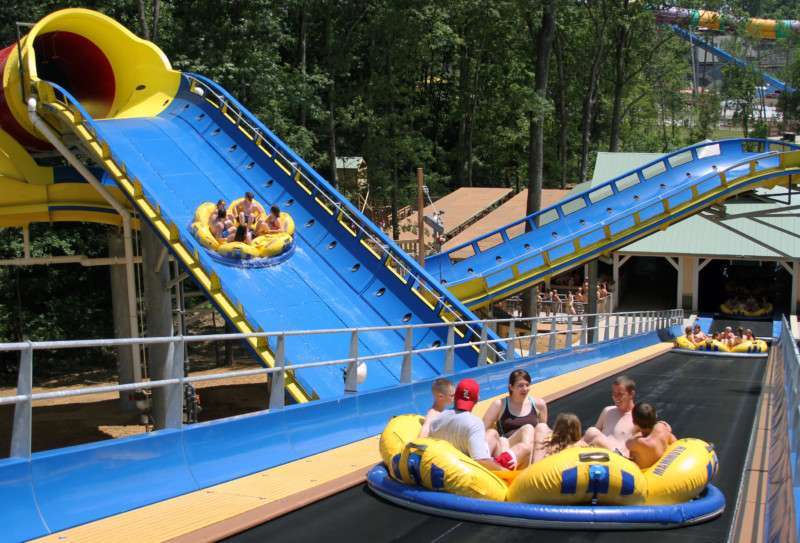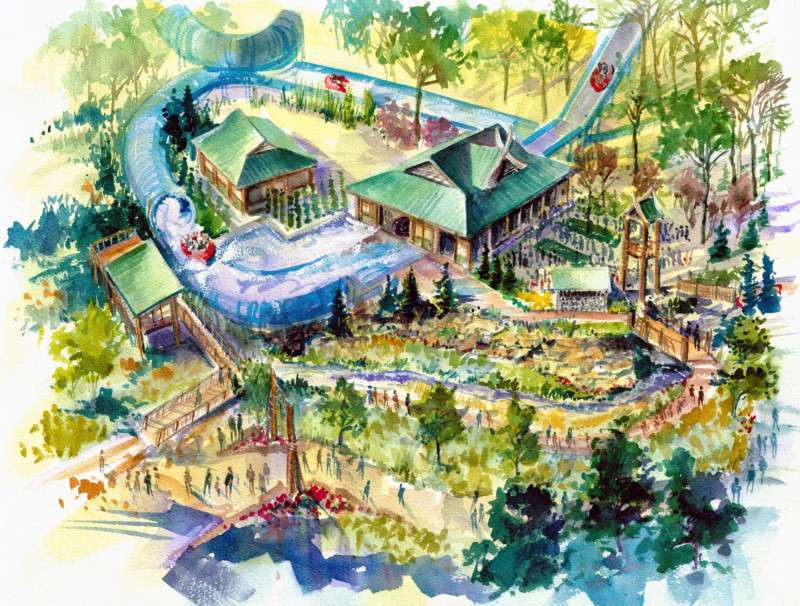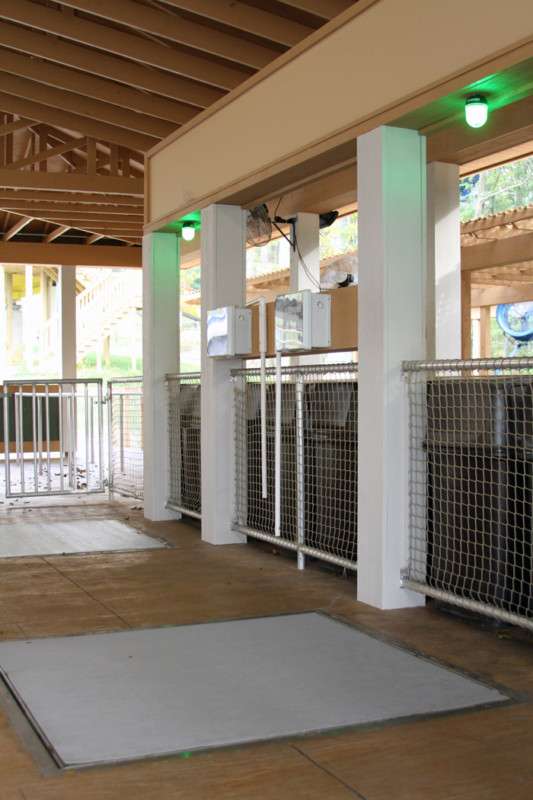creating amazing waterpark experiences involves more than waterslides
interviews by Martin Palicki
ABOVE: Guests on the completed Mammoth enjoy the unique slide. Photo courtesy of Holiday World.
This article originally appeared in InPark Magazine issue 43, published in 2012.
Holiday World and Splashin’ Safari in Santa Claus, Indiana introduced Mammoth in 2012, a new attraction from ProSlide that took their popular Hydromagnetic water coaster technology and applied it to a family style raft for up to six guests.
But a lot went into the attraction beyond just the slide. InPark talked with Rob Lippert of UStudios, who was responsible for the design and architecture of the attractions structures as well as the landscape design.
You were involved in the design and planning for Mammoth. What were you responsible for?
U-Studios Incorporated was asked to develop a concept for the queue and an aesthetic for all of the buildings associated with Mammoth. Our intent for the queue sequence was to bring guests through grasslands, boulders and low shrubbery, evolving into a heavily landscaped environment along the path, integrated within the existing woodland. As the queue and ride evolved, several structures were designed to satisfy needs in the guest area and to house the ride control equipment. These structures included a pavilion for loading and unloading
guests from the rafts, gateway tower, bridges, a structure to hold shoes while guests were riding, an observation platform overlooking the final moments on the attraction and a building for pumps and control equipment.
What were some of the unique elements you dealt with in this new ride?
Holiday World is noted for having a beautiful, natural environment, set on rolling hills covered with mature trees. Our intent was to preserve as much of this natural setting as we possibly could while still satisfying the requirements of the new ride and providing for a comfortable and shady place for guests as they wait to board. Utilizing the natural terrain and features, we were able to craft a sheltered sequence, taking advantage of mature trees, wild plants and an existing stream.
Also, working with existing woodlands, we wanted to have a minimal impact on the site, allowing the natural underbrush to come up to the path as much as possible, giving a rustic, adventuresome approach. This meant carefully laying the path through the woods with minimal re-grading. In addition, there was a natural stream that ran under the queue that was identified by the Corps of Engineers as not
to be disturbed. So we had to carefully weave the path around the stream and bridge over it when we needed to cross it.
In this early painting of the Mammoth queue and buildings, attention was given to the natural landscape and exploration feel of the attraction. Image courtesy of U Studios.
What challenges did you have to overcome?
One very unique challenge to overcome was to provide a place for guests to leave their shoes. A structure needed to be situated so that people could drop off their shoes while in the queue as they approached boarding, and yet could retrieve their shoes after disembarking the ride, without the two paths crossing in order to eliminate the possibility of line jumping as well as congestion at the shoe pavilion. We solved this by placing cubbies open on both sides between the queue and the exit path.
The ride vehicle is very dependent on the total weight of the group of guests on any given raft. We faced several challenges in designing the loading sequence. Guests needed to be organized into groups of up to six, and then they are weighed as a group. There needed to be adequate space after the scale to queue a group that falls outside the ideal weight ranges until they could be adjusted. (see sidebar)
Also, the ride was designed by ProSlide to accommodate unloading and reloading the rafts on the same platform, so people had to be carefully managed to minimize cross traffic of people exiting while others board the ride.
Have you worked with Holiday World/ Splashin’ Safari in the past? If so, on what other projects? If not, how did you find out about this project?
In 2010, we were hired by the Koch family to perform an analysis of the existing park capacity and master plan for growth over the next ten years. Immediately after completing the master plan, we were asked to address shading the queue for the Wildebeest, the smaller sibling to the Mammoth. We are currently planning renovations at the entrance to the water park and in the early phases of design for The Santa Claus Museum and Village for Mrs. Koch.
Landscaping for Mammoth was crucial to the overall design, including this rock riverbed. On the far right, the shoe cubbies are visible. Photo courtesy of U Studios.
What role did theming play in this design?
While not designed around a specific narrative, we wanted to convey an exotic place, excitement and adventure in keeping with the park’s name, Splashin’ Safari. The inspiration for the architecture and landscaped theming was drawn from imagery of jungle adventure stories. The buildings are clustered in a way that gives a feeling of an encampment in the woods, while searching for a great beast on safari. Our job also entails being sensitive to perpetuating what has been so successful all these years in this family-run park. The Koch family has a special brand
in the industry that provides for continued growth.
What do you feel are your areas of expertise?
U-Studios Incorporated has developed many techniques for delivering excellent design solutions that can be constructed for a reasonable cost. In addition to experience in the themed entertainment industry, the firm also has many years of providing services to not-for-profits. From churches to regional theaters, the firm has, time and again, been called upon for creative but cost-effective designs. An extensive art and theater background combined with years of practical knowledge of construction practices, materials and techniques makes UStudios particularly suited to working for parks with tight budgets.
In addition to being licensed architects, Gary Karasek has more than 40 years of experience in fine and visual arts. Rob Lippert has nearly 40 years of theater experience, having executed scenic design or lighting design for over 100 shows and serving as a theatrical consultant on the design of several facilities. When we combine the art and theater backgrounds with architecture, the themed entertainment industry was a natural fit for our practice.
The ability to listen to our clients and translate their goals into conceptual ideas, develop these ideas into themed architecture and finally into built realty, in a cost-effective way is our expertise.
Is designing for a waterpark different than designing for a theme park?
The mechanics of a waterpark are significantly more complex than what is needed for a dry park. In addition to typical utilities that need to be incorporated, there are miles of piping hidden under the ground that needs to be accounted for. In addition, the health codes for water parks demand extra safety and more stringent design. You are designing for wet, barefoot people. Walking surfaces can become slippery. Separating water from electricity becomes a big challenge.
What else have you learned from your experience?
As architects and creative designers, we are always looking for innovative opportunities for our clients to better serve their guests.
The idea of exit through retail is a time-tested method for generating increased product sales. But, it seems that many park operators are missing an opportunity to really engage their guests while they have them captive in the queue. We recognize that guests spend on average, 30 minutes walking to and waiting in line for a 3-minute attraction. It also seems that it would be much easier to hold the guests’ attention while they stand in line, rather than enticing them into a shop or restaurant as they walk by on their way to the next ride.
In recent discussions, we analyzed ways in which the guests could increase their enjoyment while waiting in line in addition to capturing additional revenue for the park. With the amount of time that guests spend in queue lines, it seems like a natural place to provide additional sales opportunities, whether it is products or food and beverage. As an example, the park could offer kid’s dress up photo opportunities with a character or adventurous setting, an interactive challenge based on the ride narrative with prize rewards at the end, and even a consideration of retail or food/drink vendors available in the queue line. In the new queue for the Dumbo ride in the Fantasyland expansion, Disney introduced the idea of no line and a place for children to be engaged while they wait. The next logical step should be to ask how we can capture additional revenues while they play. • • •
A Weighted Issue
The new Mammoth attraction has specific weight requirements in order for the boats to safely navigate the course. Groups of riders must fall within the acceptable range or be regrouped by park staff. To aid in this process, the park added three scales from SR Instruments, Inc. All scales are flush mount units , making it as convenient as possible for visitors and attendants . The first scale they selected was one that would be built into the walkway , making it as convenient as possible for visitors and attendants. Their plan for the ride was for this preliminary scale with a light system to sort out groups of riders. The final two scales are intended to provide a double check on the weight of riders . They are fitted with light systems providing an intuitive go/ no go check for the operator. We checked in with SR Instrument’s Sam Baker for more information on this system.
SR “purpose built” scales for MAMMOTH. Courtesy of Splashin’ Safari
Why is measuring weight important?
Ride manufacturers are applying weight limits to rides for safety reasons. That is why parks who are serious about safety are using scales. The total weight of riders has an effect on ride speed, balance, centrifugal forces,
etc. depending on the characteristics of the particular ride . Because of that it is important to stay within the limits established by the ride manufacturers.
Will we see more weighing in rides?
Scales in water parks are a recommendation of insurance companies, risk assessment consultants and others who deal in park safety issues. One individual involved in risk assessment told me he estimated 80% of the
problems in parks are due to weight issues. It is important to note that underweight is also an important safety factor – we are providing single person scales that have underweight as well as overweight light/ alarm systems.
How do you find it is best to handle this potentially sensitive issue?
From the beginning, we recognized that simplicity and efficiency were important factors for parks . They want ride attendants to be able to move riders along efficiently, avoiding confrontations. That is why we use a light system rather than showing actual weights. When we describe our products as “purpose built” we are saying the scales are specifically made for ride applications. In many cases without scales, attendants are just guessing or using height rods, which at best don’t provide much accuracy.
How is the scale working?
One of our design engineers took his family out for some vacation time and reported that they were very pleased with the scales. He was extremely impressed with the park in general. The folks at Holiday world were really great to work with and run a first class operation!
Insider Opinion
InPark spoke to Holiday World’s Dan Koch to find out where the inspiration for Mammoth came in the first place.
What made you guys decide to build Mammoth in the first place? (as opposed to a coaster, flat ride, new show, etc…) How important was the “newness” factor of the product?
Wildebeest, our first water coaster, was such a hit when it opened in 2010, we knew right away we needed to bring another ProSlide Hydromagnetic Rocket to Splashin’ Safari. When we learned about ProSlide’s new water coaster design – with six-passenger round boats – we knew we’d found our Mammoth.
How did you pick ProSlide as the slide supplier?
We have a long, successful relationship with Rick Hunter and the folks at ProSlide. We joke that we’re the showroom for their rides.
Do you find that the waterpark is a bigger draw than the theme park? Is it about equal? Do your guests spend all day in one or the other or do they split their time?
With the hot, humid weather we’ve experienced increasingly over the past decade, we’ve seen Splashin’ Safari’s appeal grow exponentially. That’s where the lines are, so that’s where we’ve been adding capacity most years. We find some Guests divide their days between the two parks while others take a day for each park. Most, though, spend the first hour or so in Holiday World, midday in Splashin’ Safari, and evening back in Holiday World.
Who supplied the rafts?
Mammoth boats are produced by Z-Pro.
Were there any operational challenges that you successfully overcame?
Any new ride design is going to have some issues, and Mammoth was no exception. We worked closely with ProSlide and Z-Pro to get the boats running smoothly so that we had very few faults after those first weeks of testing and operation.
What do you think is Mammoth’s biggest selling point to guests?
It’s just so FUN. They come off Mammoth laughing and hugging. Riding in a round, six-passenger boat provides that wonderful interaction as riders get to watch their family and friends ride – all the great reactions as they get splashed, shoot downhill backwards and then fly up the next hill. Plus, it’s the world’s longest water coaster, so our Guests love that it’s a good, long thrill ride.









